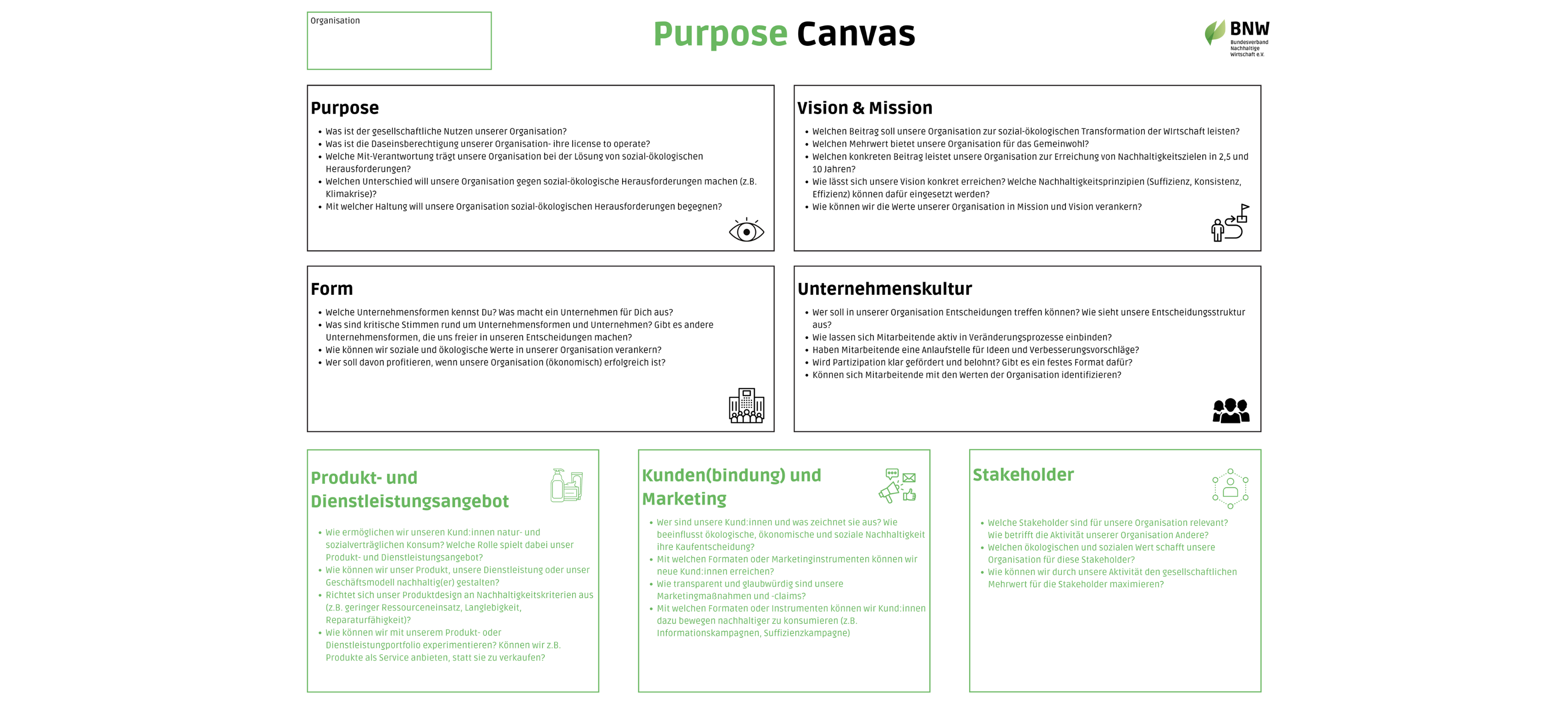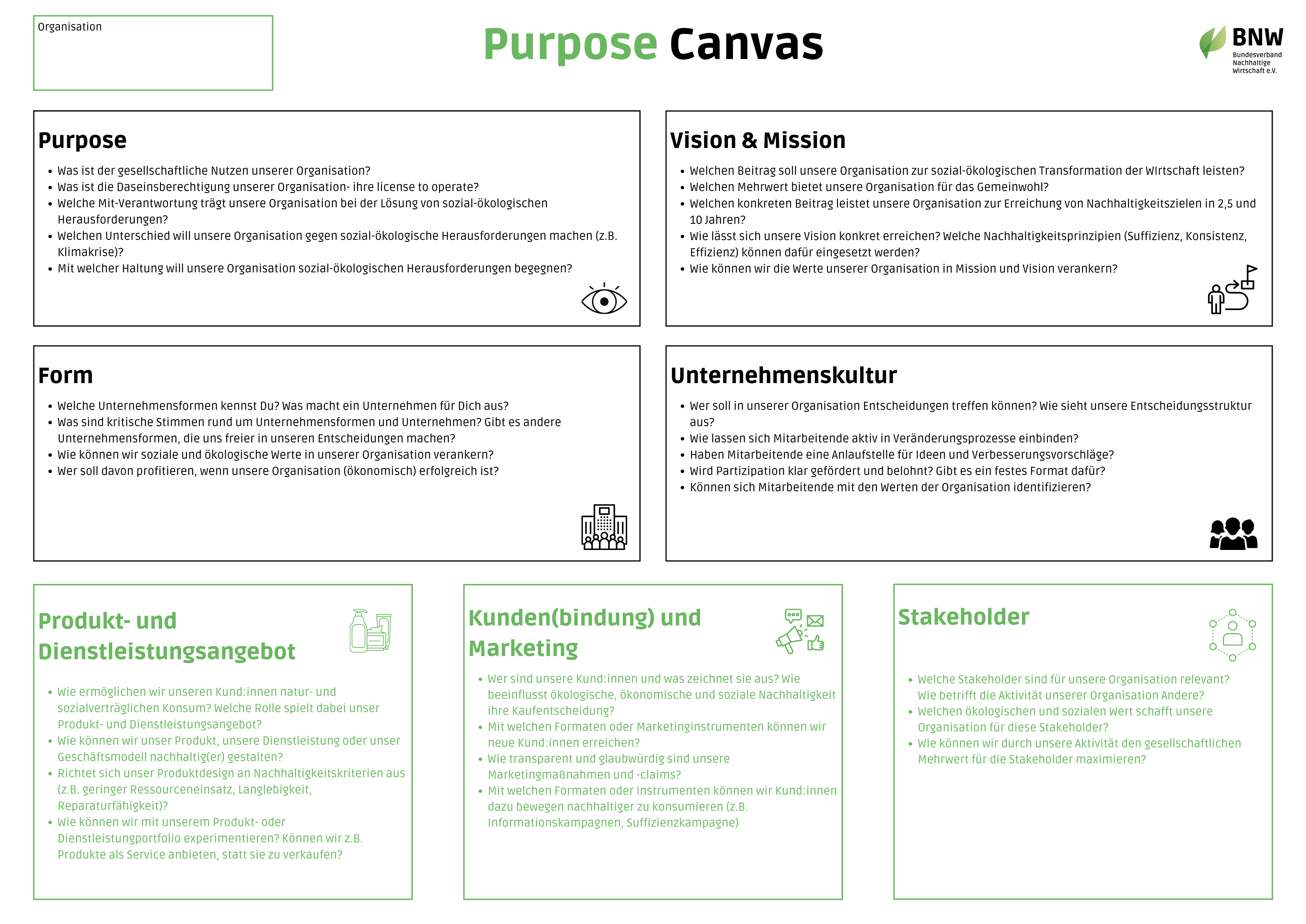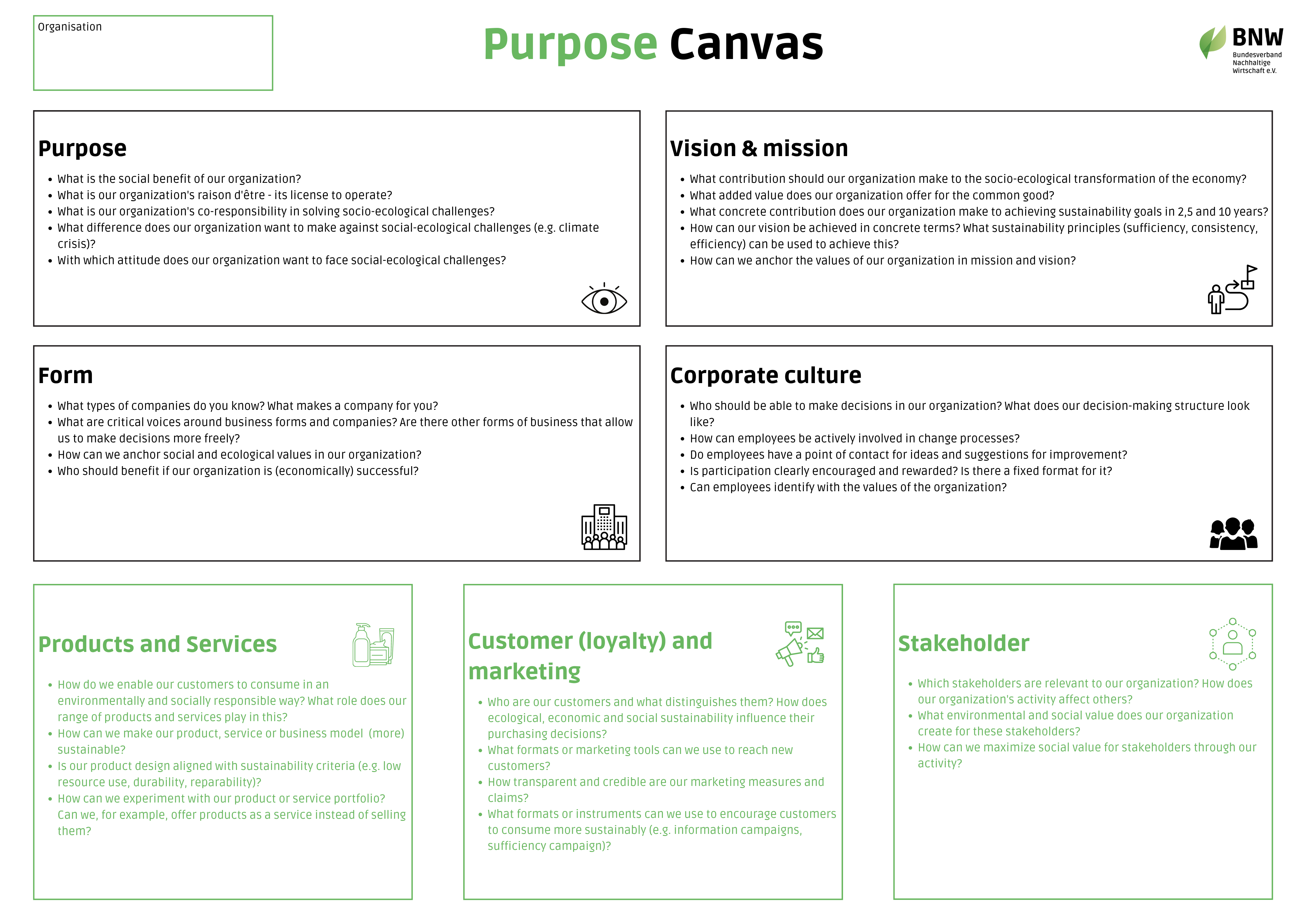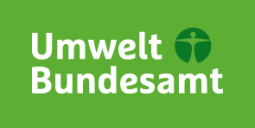Purpose Canvas
Mit dem Purpose Canvas können Unternehmen konkrete erste Schritte hin zu einer Purpose und gemeinwohlorientierten Wirtschaftsweise erarbeiten. Dabei helfen Fragen zu Purpose, Vision, Unternehmensform oder Produktangebot, die gemeinsam bearbeitet werden können. Best-Practices aus dem BNWPurpose Projekt sollen Inspiration für die Beantwortung der Fragen und für die Festlegung konkreter Maßnahmen geben. Ergänzend zum Canvas wurde ein Suffizienzstrategien-Test entwickelt, durch den Unternehmen konkrete Maßnahmen zur Suffizienzorientierung ausgegeben bekommen
With the Purpose Canvas, companies can work out concrete first steps towards a purpose and common good-oriented way of doing business. For this purpose, various questions are posed on sub-areas of the companies that can be worked on together. At some points, concrete best practices are linked to provide inspiration for answering the questions and defining concrete measures. In addition to this canvas, a sufficiency strategy test was developed to provide companies with concrete measures for sufficiency orientation.

Der Purpose Canvas
Purpose übersetzt bedeutet Zweck oder Sinn. Im unternehmerischen Kontext ist damit gemeint, dass sich Unternehmen einer tiefergehenden sozial- ökologischen Verantwortung verpflichten. Der Purpose vieler nachhaltiger Unternehmen ist es zur Lösung gesellschaftlicher Herausforderungen beizutragen. Der Unternehmenspurpose bringt also Ökologie, Ökonomie und Soziales in Einklang und definiert die Existenzberechtigung einer Organisation. Der Purpose stellt die Frage nach dem gesellschaftlichen Nutzen der Organisation und ihres Handelns. Die Ausrichtung an einem nachhaltigen Unternehmenspurpose kann eine große Strahlwirkung auf die gesamte Organisation haben. Ist der Unternehmenspurpose definiert, führt er laut einer Studie zu einer höheren Identifikation mit der Organisation und einer höheren Mitarbeiterzufriedenheit.
Leitfragen
- Was ist der gesellschaftliche Nutzen eurer Organisation?
- Was ist die Daseinsberechtigung eurer Organisation- ihre license to operate?
- Welche Mit-Verantwortung trägt eure Organisation bei der Lösung von sozial-ökologischen Herausforderungen?
- Welchen Unterschied will eure Organisation gegen sozial-ökologische Herausforderungen machen (z.B. Klimakrise, ?
- Mit welcher Haltung will eure Organisation sozial-ökologischen Herausforderungen begegnen?
Beispiele
Polarstern Energie: "Mit Energie die Welt verändern."
Wildling Shoes: "Wir sind Teil der Regeneration."
Quartiermeister: "Zum Wohle aller."
Elobau: "Create sustainable solutions."
Aus der Praxis
In unserem BNWPurpose Podcast erklärt Florian Kienbaum den Purpose Begriff und gibt spannende Praxisbeispiele.
In der Vision einer Organisation wird ein langfristiges, schwer zu erreichendes Ziel festgelegt. An diesem Ziel richtet sich das das Handeln der Organisation aus. Die Mission legt die Aufgaben fest, die die Organisation zur Erreichung der Unternehmensvision verfolgen muss. Es geht also darum kurzfristige Schritte bzw. Zwischenziele zu bestimmen. Purpose- und gemeinwohlorientierte Unternehmen definieren ihre Vision und ihre Mission mit dem Anspruch durch ihr Handeln Antworten auf sozial-ökologische Herausforderungen zu bieten. Vision und Mission sollten für Personen innerhalb und außerhalb des Unternehmens verständlich sein. Üblicherweise wird die Vision in einem kurzen Satz zusammengefasst.
Leitfragen:
- Welchen Beitrag soll unsere Organisation zur sozial-ökologischen Transformation der Wirtschaft leisten?
- Welchen Mehrwert bietet unser Unternehmen für das Gemeinwohl?
- Welchen konkreten Beitrag leistet unsere Organisation zur Erreichung von Nachhaltigkeitszielen in 2, 5 und 10 Jahren?
- Wie lässt sich unsere Vision konkret erreichen? Welche Nachhaltigkeitsprinzipien (Suffizienz, Konsistenz, Effizienz, soziale Aspekte) können dafür eingesetzt werden?
- Wie können wir die Werte unserer Organisation in Mission und Vision verankern?
Im Gegensatz zum klassischen Shareholder-Ansatz steht bei vielen purpose- und gemeinwohlorientierten Unternehmen Werteorientierung vor Profitorientierung. Vor allem Pioniere einer nachhaltigen/gemeinwohlorientierten Wirtschaftsweise zeichnet aus, dass sie die drei Themen Umwelt, Soziales und Wirtschaftlichkeit als gleichberechtigt betrachten. Die folgenden Fragen sollen dazu anregen ökologische und soziale Werte einer Organisation herauszuarbeiten. Wie können diese in der Organisation verankert werden? Die Wahl der Unternehmensform kann dabei ein Schlüssel für Organisationen sein.
Leitfragen
- Wie können wir soziale und ökologische Werte in unserer Organisation verankern?
- Wer soll davon profitieren, wenn die Organisation (ökonomisch) erfolgreich ist?
- Welche Unternehmensformen kennst Du? Was macht ein Unternehmen für Dich aus?
- Was sind kritische Stimmen rund um Unternehmensformen und Unternehmen? Gibt es andere Unternehmensformen, die euch freier in euren Entscheidungen machen?
Aus der Praxis
Inspirierende Praxisbeispiele zu Unternehmen in Verantwortungseigentum (z.B. WEtell, Waschbär) oder Social Entrepreneurship sind hier zu finden.
In purpose- und gemeinwohlorientierten Unternehmen erfahren Mitarbeiter:innen eine stärkere Einbeziehung in Entscheidungsprozesse. Dabei kann ein neues Verständnis von Führung, Zusammenarbeit und Entscheidungsfindung entstehen.
Leitfragen
- Wer soll in unserer Organisation Entscheidungen treffen können?
- Können sich die Mitarbeitenden mit den Werten der Organisation identifizieren?
- Wie lassen sich Mitarbeitende aktiv in Veränderungsprozesse einbinden?
- Haben Mitarbeitende eine Anlaufstelle für Ideen und Verbesserungsvorschläge?
- Wird Partizipation gefördert/belohnt? Gibt es ein festes Format dafür?
Aus der Praxis
Im Interview beschreiben Bio-Tiefkühlpionier Ökofrost und Wildling Shoes, wie sie selbstorganisiertes Arbeiten in ihren Organisationen umsetzen und welche Vorteile sich daraus ergeben.
Als Innovationstreiber haben Unternehmen einen großen Hebel mit den Produkten und Dienstleistungen, die sie anbieten. Purpose- und gemeinwohlorientierte Unternehmen setzen sich regelmäßig mit ihrem Produkt- und Dienstleistungsangebot auseinander. Dabei spielen vor allem die Nachhaltigkeitsprinzipien Suffizienz, Konsistenz und Effizienz eine Rolle. Oft werden Strategien und Ansätze der Kreislaufwirtschaft eingesetzt. Neben der ökologischen Perspektive müssen auch soziale Aspekte (z.B. Arbeitsbedingungen, Partizipation) berücksichtigt werden. Ziel ist es Nachhaltigkeit im Kerngeschäft und im Geschäftsmodell zu verankern. Dadurch können sich für Unternehmen auch neue (Geschäfts-)möglichkeiten ergeben.
Leitfragen
- Wie ermöglichen wir unseren Kund:innen natur- und sozialverträglichen Konsum? Welche Rolle spielt dabei unser Produkt- und Dienstleistungsangebot?
- Wie können wir unser Produkt, unsere Dienstleistung oder unser Geschäftsmodell nachhaltig(er) gestalten?
- Richtet sich unser Produktdesign an Nachhaltigkeitskriterien aus (z.B. geringer Ressourceneinsatz, Langlebigkeit, Reparaturfähigkeit)?
- Wie können wir mit unserem Produkt- oder Dienstleistungportfolio experimentieren? Können wir z.B. Produkte als Service anbieten, statt sie zu verkaufen?
Schwierigkeiten beim Ausfüllen?
Ein Test zu Suffizienzstrategien in Unternehmen ist hier zu finden. Spannende Praxisbeispiele zum nachhaltigen Produkt- und Diensleistungsangebot gibt es z.B. von VAUDE, Richard Henkel, MyBoo oder Bridge&Tunnel.
Aus strategischer Sicht können Unternehmen Marketing nutzen, um ihre Reputation zu verbessern, Kundenbeziehungen zu stärken und neue Geschäftsfelder zu erschließen. Die starke Werteorientierung von purpose- und gemeinwohlorientierten Unternehmen kann über die Unternehmenskommunikation nach außen getragen werden. Das Marketing kann zu einer stärkeren Identifikation mit dem Unternehmen verhelfen. Purpose- und gemeinwohlorientierte Unternehmen zeichnen sich vor allem dadurch aus, dass sie durch ihr Marketing nachhaltigere Konsummuster unterstützen.
Leitfragen
- Wer sind unsere Kund:innen und was zeichnet sie aus? Wie beeinflusst ökologische, ökonomische und soziale Nachhaltigkeit ihre Kaufentscheidung?
- Mit welchen Formaten oder Marketinginstrumenten können wir neue Kund:innen erreichen?
- Wie transparent und glaubwürdig sind unsere Marketingmaßnahmen und -claims?
- Mit welchen Formaten oder Instrumenten können wir Kund:innen dazu bewegen nachhaltiger zu konsumieren (z.B. Informationskampagnen, Suffizienzkampagne)?
Aus der Praxis
In einem spannenden Interview mit Nachhaltigkeitsexpertin Dr. Maike Gossen erklärt sie alles rund um das Thema suffizienzförderndes Marketing. Die Supermarktkette BIOCOMPANY hat 2019 mit ihrer "Kauf weniger" Kampagne auf sich aufmerksam gemacht. Die Beweggründe und Erkenntnisse teilt Vorstand Boris Frank im BNW Interview.
Stakeholder sind unternehmensexterne und -interne Gruppen oder Personen, die von den Aktivitäten eines Unternehmens direkt oder indirekt betroffen sind oder ein Interesse an einem Unternehmen haben (z.B. Staat, Lieferanten, Marktbegleiter). Purpose- und gemeinwohlorientierte Unternehmen gehen in den Austausch mit ihren Stakeholdern. Ihr Ziel ist es den gesellschaftlichen Mehrwert für diese Gruppen zu maximieren.
Leitfragen
- Welche Stakeholder sind für unsere Organisation relevant? Wie betrifft die Aktivität unserer Organisation Andere?
- Welchen ökologischen und sozialen Wert schafft unsere Organisation für diese Stakeholder?
- Wie können wir durch unsere Aktivität den gesellschaftlichen Mehrwert für die Stakeholder maximieren?

Purpose Canvas downloaden
Sie wollen in ihrem Unternehmen Schritte in Richtung Purpose- und Gemeinwohlorientierung gehen? Laden Sie sich den Purpose Canvas herunter und bearbeiten den Canvas mit ihren Kollegen und Kolleginnen. Inspierende Best-Practices können ihnen Anregung für das Beantworten der Fragen geben. Jetzt downloaden und sofort loslegen.
The Purpose Canvas
With the Purpose Canvas, companies can work out concrete first steps towards a purpose and common good-oriented way of doing business. For this purpose, various questions are posed on sub-areas of the companies that can be worked on together. At some points, concrete best practices are linked to provide inspiration for answering the questions and defining concrete measures. In addition to this canvas, a sufficiency strategy test was developed to provide companies with concrete measures for sufficiency orientation.
The Purpose Canvas
Purpose translated means purpose or meaning. In a business context, it means that companies are committed to a deeper social and environmental responsibility. The purpose of many sustainable companies is to contribute to solving social challenges. The corporate purpose thus harmonizes ecology, economy and social issues and defines an organization's raison d'être. The Purpose poses the question of the social benefit of the organization and its actions. Alignment with a sustainable corporate purpose can have a major impact on the entire organization. According to one study, if the corporate purpose is defined, it leads to higher identification with the organization and higher employee satisfaction. In our BNWPurpose Podcast, Florian Kienbaum explains the concept of Purpose and gives exciting practical examples.
Guiding questions
- What is the social benefit of your organization?
- What is your organization's raison d'être - its license to operate?
- What is your organization's co-responsibility in solving socio-ecological challenges?
- What difference does your organization want to make against socio-ecological challenges (e.g. climate crisis, ?)?
- With which attitude does your organization want to face social-ecological challenges?
Examples
Polarstern Energie: "Changing the world with energy."
Wildling Shoes: "We are part of the regeneration."
Quartiermeister: "For the good of all."
Elobau: "Create sustainable solutions."
An organization's vision sets a long-term goal that is difficult to achieve. The organization's actions are guided by this goal. The mission defines the tasks that the organization must pursue in order to achieve the corporate vision. It is therefore a matter of defining short-term steps or intermediate goals. Purpose and common good oriented companies define their vision and mission with the claim to offer answers to social-ecological challenges through their actions. Vision and mission should be understandable for people inside and outside the company. Typically, the vision is summarized in a short sentence.
Guiding questions
- What contribution should our organization make to the social-ecological transformation of the economy?
- What added value does our company provide for the common good?
- What concrete contribution will our organization make to achieving sustainability goals in 2, 5 and 10 years?
- How can our vision be achieved in concrete terms? Which sustainability principles (sufficiency, consistency, efficiency, social aspects) can be used to achieve this?
- How can we anchor the values of our organization in mission and vision?
In contrast to the classic shareholder approach, many purpose- and community-oriented companies place value orientation before profit orientation. In particular, pioneers of a sustainable/common-good approach to business are characterized by the fact that they regard the three issues of environment, social issues and economic efficiency as being of equal importance. The following questions are intended to stimulate the elaboration of ecological and social values of an organization. How can these be anchored in the organization? The choice of corporate form can be a key to this for organizations.
Guiding questions
- How can we anchor social and ecological values in our organization?
- Who should benefit if the organization is (economically) successful?
- Which forms of enterprise do you know? What makes an enterprise for you?
- What are critical voices around enterprise forms and enterprises? Are there other forms of enterprise that make you freer in your decisions?
Best-Practices
Inspiring practical examples of responsibly owned companies (e.g. WEtell, Waschbär) or social entrepreneurship can be found here.
In purpose- and common good-oriented companies, employees experience greater involvement in decision-making processes. This can lead to a new understanding of leadership, collaboration and decision-making.
Guiding questions
- Who should be able to make decisions in our organization?
- Can employees identify with the values of the organization?
- How can employees be actively involved in change processes?
- Do employees have a point of contact for ideas and suggestions for improvement?
- Is participation encouraged/rewarded? Is there a fixed format for it?
Best-Practices
In this interview, organic frozen food pioneer Ökofrost and Wildling Shoes describe how they implement self-organized working in their organizations and the benefits it brings.
As drivers of innovation, companies have great leverage with the products and services they offer. Purpose- and public good-oriented companies regularly address their product and service offerings. In particular, the sustainability principles of sufficiency, consistency and efficiency play a role. Circular economy strategies and approaches are often used. In addition to the ecological perspective, social aspects (e.g. working conditions, participation) must also be taken into account. The goal is to anchor sustainability in the core business and in the business model. This can also create new (business) opportunities for companies.
Key questions
- How do we enable our customers to consume in an environmentally and socially responsible way? What role do our products and services play in this?
- How can we make our product, service or business model more sustainable?
- Is our product design aligned with sustainability criteria (e.g. low resource use, durability, reparability)?
- How can we experiment with our product or service portfolio? For example, can we offer products as a service instead of selling them?
Best-Practices
A test on sufficiency strategies in companies can be found here. Exciting practical examples on sustainable product and service offerings can be found e.g. from VAUDE, Richard Henkel, MyBoo or Bridge&Tunnel.
From a strategic point of view, companies can use marketing to improve their reputation, strengthen customer relationships and open up new business areas. The strong value orientation of purpose- and community-oriented companies can be communicated to the outside world via corporate communications. Marketing can help them to identify more strongly with the company. Purpose- and public good-oriented companies are characterized above all by the fact that they support more sustainable consumption patterns through their marketing.
Guiding questions
- Who are our customers and what distinguishes them? How does environmental, economic and social sustainability influence their purchasing decisions?
- What formats or marketing tools can we use to reach new customers?
- How transparent and credible are our marketing measures and claims?
- What formats or instruments can we use to encourage customers to consume more sustainably (e.g. information campaigns, sufficiency campaign)?
Best-Practices
In an exciting interview with sustainability expert Dr. Maike Gossen, she explains everything about the topic of sufficiency-promoting marketing. Supermarket chain BIOCOMPANY attracted attention in 2019 with its "Buy Less" campaign. Board member Boris Frank shares the motivations and insights in the BNW interview.
Stakeholders are groups or persons external or internal to the company who are directly or indirectly affected by the activities of a company or have an interest in a company (e.g. government, suppliers, market competitors). Purpose- and common good-oriented companies enter into an exchange with their stakeholders. Their goal is to maximize social value for these groups.
Guiding questions
- Which stakeholders are relevant to our organization? How does our organization's activity affect others?
- What environmental and social value does our organization create for these stakeholders?
- How can we maximize societal value for stakeholders through our activity?

Download Purpose Canvas
Do you want to take steps towards purpose and common good orientation in your company? Download the Purpose Canvas and work through it with your colleagues. Inspiring best practices can give them inspiration for answering the questions. Download now and get started immediately.
Das Projekt “Purpose- und gemeinwohlorientiertes Wirtschaften für mehr Resilienz in Krisensituationen” wird gefördert durch das Umweltbundesamt und das Bundesministerium für Umwelt, Naturschutz, nukleare Sicherheit und Verbraucherschutz. Die Mittelbereitstellung erfolgt auf Beschluss des Deutschen Bundestages.

